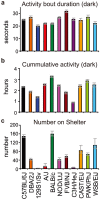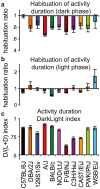Sheltering behavior and locomotor activity in 11 genetically diverse common inbred mouse strains using home-cage monitoring
- PMID: 25264768
- PMCID: PMC4180925
- DOI: 10.1371/journal.pone.0108563
Sheltering behavior and locomotor activity in 11 genetically diverse common inbred mouse strains using home-cage monitoring
Abstract
Functional genetic analyses in mice rely on efficient and in-depth characterization of the behavioral spectrum. Automated home-cage observation can provide a systematic and efficient screening method to detect unexplored, novel behavioral phenotypes. Here, we analyzed high-throughput automated home-cage data using existing and novel concepts, to detect a plethora of genetic differences in spontaneous behavior in a panel of commonly used inbred strains (129S1/SvImJ, A/J, C3H/HeJ, C57BL/6J, BALB/cJ, DBA/2J, NOD/LtJ, FVB/NJ, WSB/EiJ, PWK/PhJ and CAST/EiJ). Continuous video-tracking observations of sheltering behavior and locomotor activity were segmented into distinguishable behavioral elements, and studied at different time scales, yielding a set of 115 behavioral parameters of which 105 showed highly significant strain differences. This set of 115 parameters was highly dimensional; principal component analysis identified 26 orthogonal components with eigenvalues above one. Especially novel parameters of sheltering behavior and parameters describing aspects of motion of the mouse in the home-cage showed high genetic effect sizes. Multi-day habituation curves and patterns of behavior surrounding dark/light phase transitions showed striking strain differences, albeit with lower genetic effect sizes. This spontaneous home-cage behavior study demonstrates high dimensionality, with a strong genetic contribution to specific sets of behavioral measures. Importantly, spontaneous home-cage behavior analysis detects genetic effects that cannot be studied in conventional behavioral tests, showing that the inclusion of a few days of undisturbed, labor extensive home-cage assessment may greatly aid gene function analyses and drug target discovery.
Conflict of interest statement
Figures






References
-
- Tecott LH, Nestler EJ (2004) Neurobehavioral assessment in the information age. Nat Neurosci 7: 462–466 Available: http://www.ncbi.nlm.nih.gov/entrez/query.fcgi?cmd=Retrieve&db=PubMed&dop.... - PubMed
-
- Roberts A, Pardo-Manuel de Villena F, Wang W, McMillan L, Threadgill DW (2007) The polymorphism architecture of mouse genetic resources elucidated using genome-wide resequencing data: implications for QTL discovery and systems genetics. Mamm Genome 18: 473–481 Available: http://www.ncbi.nlm.nih.gov/entrez/query.fcgi?cmd=Retrieve&db=PubMed&dop.... - PMC - PubMed
-
- De Visser L, van den Bos R, Kuurman WW, Kas MJ, Spruijt BM (2006) Novel approach to the behavioural characterization of inbred mice: automated home cage observations. Genes Brain Behav 5: 458–466 Available: http://www.ncbi.nlm.nih.gov/entrez/query.fcgi?cmd=Retrieve&db=PubMed&dop.... - PubMed
-
- Jhuang H, Garrote E, Yu X, Khilnani V, Poggio T, et al. (2010) Automated home-cage behavioural phenotyping of mice. Nat Commun 1: 68 Available: http://www.ncbi.nlm.nih.gov/entrez/query.fcgi?cmd=Retrieve&db=PubMed&dop.... - PubMed
-
- Kas MJ, de Mooij-van Malsen JG, de Krom M, van Gassen KL, van Lith HA, et al. (2009) High-resolution genetic mapping of mammalian motor activity levels in mice. Genes Brain Behav 8: 13–22 Available: http://www.ncbi.nlm.nih.gov/entrez/query.fcgi?cmd=Retrieve&db=PubMed&dop.... - PubMed
Publication types
MeSH terms
LinkOut - more resources
Full Text Sources
Other Literature Sources
Molecular Biology Databases
Miscellaneous

